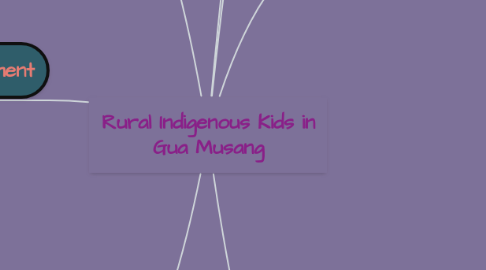
1. Only interested in doing physical activities
2. The needs to score for UPSR
3. Make the kids interested to learn language
3.1. Didi and friends' songs
4. Design & Develop
4.1. Instructional Content Analysis
4.1.1. Alphabet
4.1.2. Syllables
4.1.3. Simple vocabulary
4.2. Instructional goals
4.2.1. Able to recognize alphabet
4.2.2. Able to introduce themselves using simple sentences
4.3. Instructional task analysis (Procedural Analysis Method)
4.3.1. Able to recognize alphabet
4.3.1.1. Input
4.3.1.1.1. Teach the sounds in English words to low/none proficient students
4.3.1.2. Process Step
4.3.1.2.1. Phonics method
4.3.1.3. Output
4.3.1.3.1. Students should be able to identify certain sounds in a word
4.3.2. Able to remember simple vocabulary using syllables method
4.3.2.1. Input
4.3.2.1.1. Teach them to be alert with syllables in a word
4.3.2.2. Process Step
4.3.2.2.1. Use claves to make them aware of the syllables
4.3.2.3. Output
4.3.2.3.1. Students should be able to present assign words' syllables to the class
4.3.3. Able to introduce themselves using simple sentences
4.3.3.1. Input
4.3.3.1.1. Facilitate them in constructing basic grammatical/ungrammatical sentences to introduce themselves
4.3.3.2. Process Step
4.3.3.2.1. Help them to construct the sentences
4.3.3.3. Output
4.3.3.3.1. Produce a video compilation of their introduction (boost their confidence)
4.3.4. Able to remember simple vocabulary using syllables method
5. Analysis
5.1. Learning Environment Analysis
5.1.1. No one encourages them to go to school
5.1.1.1. Scared of learning new things
5.1.2. Limited internet connection (at home)
5.2. Learner Analysis
5.2.1. Age
5.2.1.1. 8-9 years old kids
5.2.2. Attitude
5.2.2.1. Lack of interest
5.2.3. Way of living
5.2.3.1. Live in community (friends and family)
5.2.3.1.1. Stick to traditions/traditional way of living
5.2.4. Entry Behaviour
5.2.4.1. Low proficiency or none at all
5.2.4.1.1. Lack of exposure to English medium
5.3. Learner Needs
5.3.1. Exposure towards communication in English
5.3.2. Interest in learning English
5.3.2.1. More guidance from parents & teachers
5.3.3. More Learning resources
5.3.4. Better access
5.3.5. To gain soft skills
5.3.5.1. Communication skills
6. Implement
6.1. Hard
6.1.1. Claves (Bamboo)
6.1.1.1. Teach the kids syllables
6.1.1.1.1. Mon-day, Wed-Nes-Day
6.1.2. Velcro kit
6.1.2.1. Teach the kids alphabets
6.1.3. Videos/songs
6.1.4. Collaboration with the parents
6.1.4.1. Cooking, spree cleaning
6.1.4.1.1. Gain trust from the family
6.1.4.1.2. Make the learning process easier
6.1.5. Flashcards
6.1.5.1. Remember words by knowing what those items look like
6.1.5.1.1. Easy for them to memorize words
6.1.6. Stationery
6.1.6.1. Beneficial for them since some of them cannot afford it
6.1.6.1.1. Motivate them to study harder
6.2. Soft
6.2.1. Field trip
6.2.1.1. Know about the outside world
6.2.1.1.1. Social change
6.2.1.2. Going outside of Gua Musang
6.2.1.2.1. Experience makes them want to learn more
6.2.2. Instill role model
6.2.2.1. Know their future
6.2.2.2. Have someone to idolize
6.2.2.3. They like doing things in their community
6.2.3. Community
6.2.3.1. Less insecure by being surrounded by the same kinds
7. Evaluate
7.1. Medium
7.1.1. Quizzes using Mini Whiteboard
7.1.1.1. Observe their performance
7.1.1.1.1. Prove the effectiveness of the learning process
7.1.1.2. Improve their competitiveness in class
7.1.1.2.1. They will be competing for the rewards
7.1.2. KAHOOT!
7.1.2.1. Grab their interest by using technology
7.1.2.1.1. Improve their thinking skills within time given
7.2. Reward
7.2.1. Candy
7.2.1.1. Make sure that the students to remain motivated and interested throughout the game
